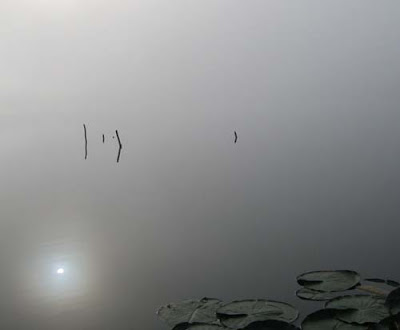The Stumbling Block of Enlightenment
As stated in my previous post on the subject, what Buddhists refer to as enlightenment is nothing other than a
profound realization of the most fundamental truth regarding the emptiness of all things (sunyata in Sanskrit). Myriad other
Buddhist teachings can be understood as various facets of this diamond-like
truth. For example, it is emptiness that
has us speaking in terms of dependent origination, interbeing, and the non-dual;
and it is emptiness that has us speaking
of the three marks of existence: the impermanence of all things, the lack of
inherent selfhood of all things, and the unsatisfactory nature of all things. The
last of these, by the way, is merely the first noble truth – the truth of
suffering – viewed from a slightly different angle.
However, it is the second noble
truth that points to the fundamental difficulty of human existence: our almost
unrelenting tendency to overlay the infinite potential inherent in the
emptiness of all things with our own finite and often downright fanciful ideas
and conceptualizations. If we could only just see things as they are, and
accept things as they are, we wouldn’t experience suffering as we do.
Unfortunately, what glimpses we might catch from time to time of such an enlightened
way of seeing are as fleeting as any other phenomena. And so we’re left
speculating as to what the perfect, universal, and lasting enlightenment of the
buddhas might be like – anuttara-samyaksambodhi.
Especially insidious, though, is our tendency to overlay the clear seeing of
enlightenment itself with fantastical ideas about it conjured up in our
imaginations, or in the imaginations of others.
For example, I read a story some
years ago of a Buddhist monk who discovered that he was coming down with
something – a cold or the flu, nothing too serious. It threw him for a loop, though, because he’d
come to think of himself as enlightened, and enlightened individuals don’t get
sick! Now, I don’t recall, if indeed the story conveyed, what made this person
think that he was enlightened. Perhaps he’d had a so-called enlightenment
experience of some kind, or solved a series of koans, or been recognized as a
recipient of something called mind to mind transmission from one who’d received
it from someone else, and so on. At any rate, whatever enlightenment this monk had
“attained” couldn’t liberate him from the suffering caused by his own
overvalued (superstitious?) ideas of what enlightenment actually is.
But how did such fantastical ideas
get all tangled up in our thinking about enlightenment in the first place? One
possible answer is that the Buddha was way ahead of his time, speaking of a
truth that few of his followers could comprehend. Thus, when the Buddha’s
teachings began to actually be recorded hundreds of years later, all manner of
misconceptions and cultural baggage got thrown into the mix as well. A teaching
became a religion; and what would a religion be without a hero of some sort,
replete with special powers. Christianity has the risen Christ, Islam has the
miracles of The Prophet, and Buddhism, in the minds of many, has supernatural
powers attributed to the Awakened One. Another possibility is that our
collective understanding of emptiness is evolving along with the practice of
Buddhism. Perhaps the Buddha nudged humanity’s collective understanding toward
a blossoming of emptiness that is underway even as we speak – furthered by the
meditative practice of uncounted individuals. Thus, part of our enlightened
activity is to weigh myth and experience, and continue blossoming forth.
We’re all a tangled knot of wisdom and delusion. We
can see clearly one minute, then have our vision obscured by dense fog in the
next, without ever even noticing the difference. As such, one of the wisest
things I’ve ever heard said about enlightenment is that “strictly speaking,
there are no enlightened people, there is only enlightened activity” (Shunryu
Suzuki, as quoted in Kornfield, 2001). Why, then, do we continue this pretense
that certain individuals are the embodiment of enlightenment – as the Buddha
himself purportedly was? It’s as if we so long for transcendence that we can’t
help but project our mythical thinking about it onto those teachers and
figureheads that seem to “fit the bill” in some way, shape, or form.
Unfortunately, such a view is predicated
on a dualistic way of looking at the world that runs counter to the true nature
of emptiness. When we say that this person is enlightened, but that one is not,
we’re overlaying the fundamentally empty nature of reality with our own
conceptual framework. We’ve torn away a piece from an otherwise seamless fabric.
When we think in terms of an individual moving from the ranks of the
unenlightened to the ranks of the enlightened, we’re thinking in terms of them
having gained something, and “gaining something” is contrary to the fundamentally
empty nature of reality as well.
But even more important, with
respect to the liberative quality of Buddhist teachings, is the fact that
locating enlightenment outside of “the self that is not other” artificially
cleaves us from that which is our birthright. Nirvana and samsara are
inseparable from each other, and we are inseparable from them. In fact nirvana
and samsara are one and the same in the subsequently evolved Madhyamika view of emptiness. Thus, look for
enlightenment in the "nooks and crannies" of your everyday life. Look for clear
seeing to arise spontaneously as the fog clears for a time before obscuring
things once again. You’ll overlook such occurrences in your day to day
existence if you keep clinging to deluded ideas of what enlightenment is all about.
References
Kornfield, J. (2001). After
the ecstasy, the laundry: How the heart grows wise on the spiritual path.
Bantam Books.
Image
Credits
Copyright 2018 by Mark Robert Frank




Comments
Post a Comment